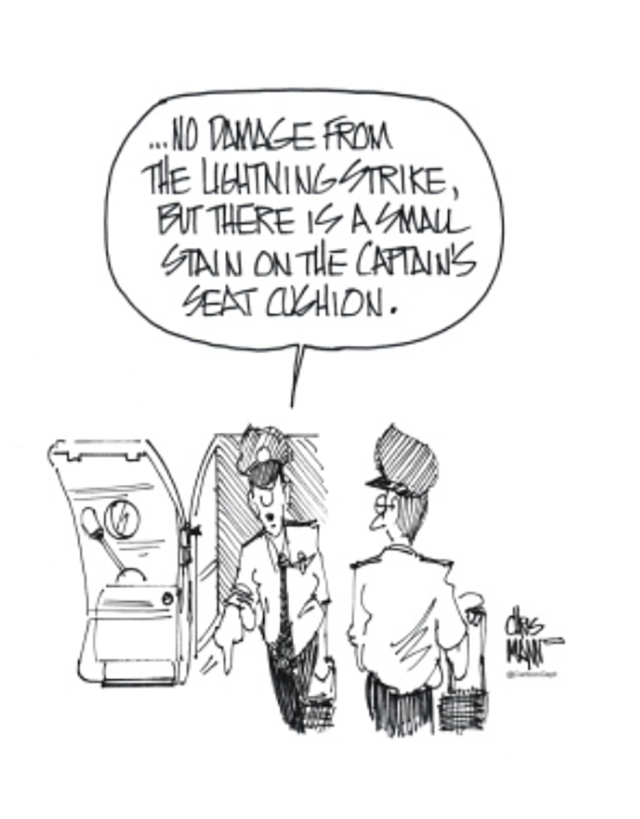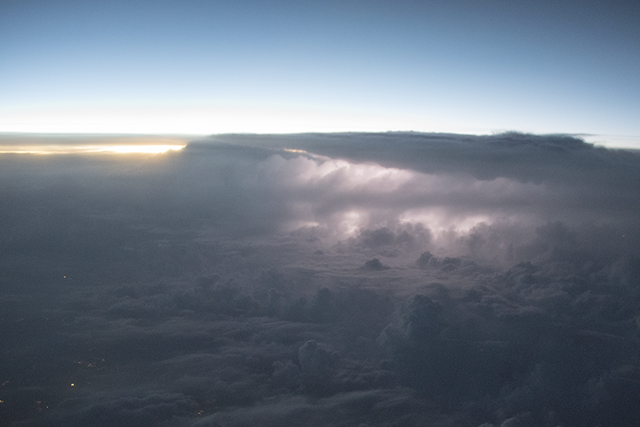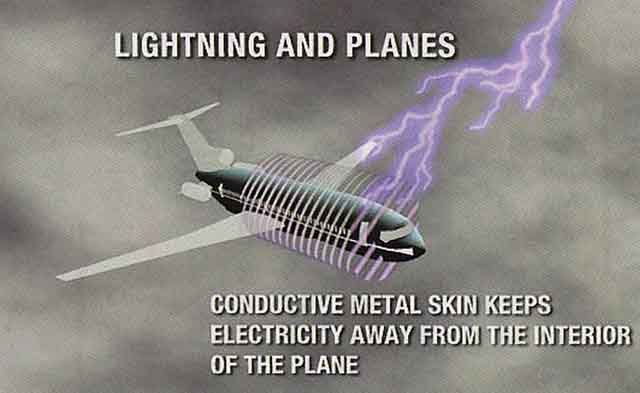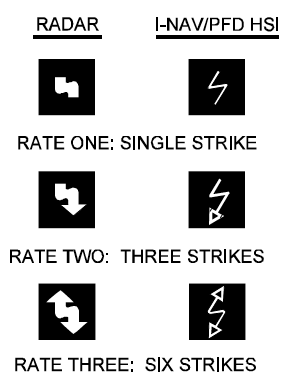Theoretically, a lightning strike should enter one part of the airplane and exit from another with very little damage to the airplane. Theoretically. I've had this happen twice where theory didn't measure up to reality.
— James Albright

Updated:
2017-09-15
The first time was in a Boeing 707 (EC-135J) where the strike knocked all our generators off line and we ended up flying by reference to a back up system on the copilot's side. The second time was in a Boeing 747 (E-4B) where we seemed to lose half of everything and the exit point blew out about five square feet of horizontal stabilizer. I've come to the conclusion that both strikes were a result of us flying where we shouldn't be. (But we did a lot of that in the Air Force.) So try not to fly where lightning is likely.
1 — Anatomy of a lightning stroke

1
Anatomy of a lighting stroke
Although a lightning stroke can be displayed in infinite ways, they all have the same formative process. This process starts with positive and negative charges building up in different places—either within a cloud, between 2 clouds, or between a cloud and the ground. Don't worry, though—your aircraft is incapable of building a sufficient charge to trigger a lightning stoke.
When the electrical difference between the positive and negative charges becomes great enough, the negatively-charged electrons become attracted to the positively-charged regions and start to flow toward them. The trail blazed by the electrons, commonly from the base of the cloud toward the ground, is known as a stepped leader. It is stepped because the electrons surge about 50 meters at a time, pausing for about 50 microseconds before surging the next 50 meters.
On the other end, as the stepped leader approaches, positive ions are drawn toward it. When the 2 channels connect, the circuit is established and the positive charge flows quickly up the ion channel towards the cloud. The speed at which the return stroke moves up the channel is about 1/3 the speed of light, which often makes the motion of longer flashes visible to the eye.
The light in lightning is due to the current heating the air molecules to about 50,000 °F.
Source: Shein
2
What makes lightning dangerous
For a lightning stroke to happen requires a potential of around 3 billion volts per kilometer. This means that for a cloud base 1 km from the ground, 3 billion volts of charge difference is necessary for cloud-to-ground lightning discharge to occur.
Because the huge potential is discharged almost instantaneously, the current is incredible. A typical lightning stroke discharges at a current of around 2,000 - 40,000 Amps.
Source: Shein
3
Lightning and aircraft
It is unlikely an aircraft can generate a positive or negative charge large enough to generate a lightning bolt. Instead, an aircraft simply acts as a path of least resistance as it flies between 2 polarized regions of clouds. A nearby stepped leader will pass through an aircraft since it will be more conductive than a nearby path of empty air.
When lighting does pass through an aircraft, it will generally begin by attaching to an extremity, such as a wing tip, nacelle or antenna. The path will then migrate aft as the aircraft moves forward, attaching to other spots until charge has been neutralized. Where the lightning strikes the aircraft, the intense heat may scorch the skin or even burn a small hole. Lightning channels are at most around 4 inches in diameter. Aircraft with conductive skins, such as aluminum, tend to fare better with lightning strikes than those without. Modern aircraft with fiber composites skins generally incorporate a thin layer of conductive material into the skin.
Source: Shein
While an aircraft's skin and frame will serve to channel the energy from a lightning strike away from occupants and critical internal systems, there remain a few places that are susceptible to damage. External antennae as well as radar and antennae housed behind nonconductive nacelles or radomes are susceptible.
Lightning can disorient or temporarily blind the pilot. At low altitudes, such as during takeoff or landing, this debilitation could prove disastrous.
4
Avoidance
Above all, remember this: never regard any thunderstorm “lightly” even when radar observers report the echoes are of light intensity. Avoiding thunderstorms is the best policy. Following are some Do’s and Don’ts of thunderstorm avoidance:
- Don’t land or takeoff in the face of an approaching thunderstorm. A sudden gust front of low level turbulence could cause loss of control.
- Don’t attempt to fly under a thunderstorm even if you can see through to the other side. Turbulence and wind shear under the storm could be disastrous.
- Don’t fly without airborne radar into a cloud mass containing scattered embedded thunderstorms. Scattered thunderstorms not embedded usually can be visually circumnavigated.
- Don’t trust the visual appearance to be a reliable indicator of the turbulence inside a thunderstorm.
- Do avoid by at least 20 miles any thunderstorm identified as severe or giving an intense radar echo. This is especially true under the anvil of a large cumulonimbus.
- Do clear the top of a known or suspected severe thunderstorm by at least 1,000 feet altitude for each 10 knots of wind speed at the cloud top. This should exceed the altitude capability of most aircraft.
- Do circumnavigate the entire area if the area has 6/10 thunderstorm coverage.
- Do remember that vivid and frequent lightning indicates the probability of a strong thunderstorm.
- Do regard as extremely hazardous any thunderstorm with tops 35,000 feet or higher whether the top is visually sighted or determined by radar.
If you cannot avoid penetrating a thunderstorm, following are some Do’s before entering the storm:
- Tighten your safety belt, put on your shoulder harness if you have one and secure all loose objects.
- Plan and hold your course to take you through the storm in a minimum time.
- To avoid the most critical icing, establish a penetration altitude below the freezing level or above the level of minus 15 degrees Celsius.
- Verify that pitot heat is on and turn on carburetor heat or jet engine anti-ice. Icing can be rapid at any altitude and cause almost instantaneous power failure and/or loss of airspeed indication.
- Establish power settings for turbulence penetration airspeed recommended in your aircraft manual.
- Turn up cockpit lights to highest intensity to lessen temporary blindness from lightning.
- If using automatic pilot, disengage altitude hold mode and speed hold mode. The automatic altitude and speed controls will increase maneuvers of the aircraft thus increasing structural stress.
- If using airborne radar, tilt the antenna up and down occasionally. This will permit you to detect other thunderstorm activity at altitudes other than the one being flown.
Following are some Do’s and Don’ts during the thunderstorm penetration:
- Do keep your eyes on your instruments. Looking outside the cockpit can increase danger of temporary blindness from lightning.
- Don’t change power settings; maintain settings for the recommended turbulence penetration airspeed.
- Don’t attempt to maintain constant altitude; let the aircraft “ride the waves.”
- Don’t turn back once you are in the thunderstorm. A straight course through the storm most likely will get you out of the hazards most quickly. In addition, turning maneuvers increase stress on the aircraft.
Source: AIM, §7−1−29. Thunderstorm Flying
5
Lightning detector
The G-450 Lightning Sensor System (LSS) is an antenna located at the top of the vertical stabilizer to detect the electromagnetic energy released during lightning strikes within a two hundred (200) mile range of the aircraft. The system is capable of tracking up to fifty (50) areas of lightning activity simultaneously. A system processor determines the range and bearing of the lightning energy pulse and forwards the information to the MAUs for formatting and display on the active radar presentation(s).
Lightning strikes are represented by white icons with a single strike shown as only a jagged line, medium activity as a jagged line with an arrow head at the bottom of the line, and areas of intense lightning depicted as a jagged line with arrowheads at the top and bottom of the line.
The display criteria is a function of frequency of lightning strikes within a two (2) minute period for a given area. A medium intensity icon is displayed if three to five (3 - 5) strikes occur in the same vicinity within two (2) minutes, and an area that suffers six (6) or more lightning strikes within two (2) minutes is marked by the intense lightning icon. The initial icon display for a given area will change if the rate of lighting activity within the monitored time period changes - i.e. if an area of intense activity decreases to a level of four (4) strikes per two (2) minute period, the icon will change to the medium activity format.
References
(Source material)
Aeronautical Information Manual
Shein, Karsten, "Lightning Rods," Professional Pilot, Jun 2012



